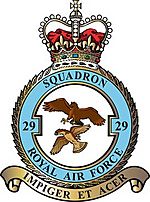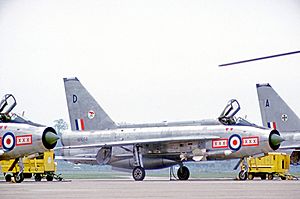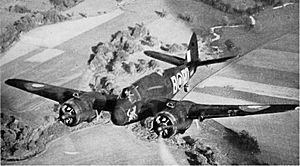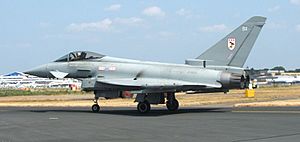No. 29 Squadron RAF facts for kids
Quick facts for kids No. 29 Squadron RAF |
|
|---|---|

Squadron badge
|
|
| Active |
|
| Country | |
| Branch | |
| Type | Operational Conversion Unit |
| Role | Typhoon training |
| Part of | No. 1 Group RAF |
| Home station | RAF Coningsby |
| Motto(s) | Impiger et Acer (Latin for 'Energetic and keen') |
| Aircraft | Eurofighter Typhoon FGR4 |
| Battle honours |
|
| Insignia | |
| Squadron tail badge |  |
| Squadron badge heraldry | An eagle in flight, preying on a buzzard - representing air combat. |
| Squadron roundel | |
| Squadron Codes | YB (Dec 1938 – Sep 1939) RO (Sep 1939 – Apr 1951) BA–BZ (1987 – present) |
No. 29 Squadron is a famous unit of the Royal Air Force (RAF). It was first started in 1915 as part of the Royal Flying Corps. This makes it one of the oldest fighter squadrons in the world! Today, it's the second British squadron to use the Eurofighter Typhoon. It acts as the main training unit for pilots learning to fly the Typhoon.
Contents
The Squadron's Story: A Look Back
Early Days: World War I Fighters
No. 29 Squadron began in November 1915. At first, it was a reserve squadron, flying planes like the Royal Aircraft Factory B.E.2c. But in early 1916, it got the Airco DH.2 "pusher" fighter. This plane had its propeller at the back.
The squadron arrived in France on March 25, 1916. They helped stop the "Fokker Scourge," a time when German planes were very strong. Their efforts helped the Allies gain control of the skies before the Battle of the Somme.
By late 1916, newer German fighters made the DH.2 less effective. But No. 29 Squadron kept their DH.2s until March 1917. Then, they got Nieuport 17 planes, which were faster. They later received even newer Nieuport models.
In April 1918, the squadron finally received the Royal Aircraft Factory S.E.5a. This was a very good fighter plane, and they used it for the rest of the war.
One of the squadron's heroes was Captain James McCudden. He was awarded the Victoria Cross on April 2, 1918. This is the highest award for bravery in the British Empire. He earned it for his amazing courage and dedication between August 1917 and March 1918.
The war ended for the squadron in August 1919 when they returned to the UK. They were officially closed down on December 31, 1919. By the end of the war, the squadron had claimed 385 enemy planes. Many skilled pilots, known as "aces," flew with No. 29 Squadron.
Between the Wars: New Planes and Missions
The squadron was started up again on April 1, 1923. They first flew Sopwith Snipes, then Gloster Grebes in 1925. Later, they used Armstrong Whitworth Siskin IIIA planes and Bristol Bulldogs.
In March 1935, they received Hawker Demons, which were two-seater planes. They even served in Egypt from 1935 to 1936 during a crisis there. As the RAF grew, No. 29 Squadron got Bristol Blenheim IF heavy fighters in December 1938.
World War II: Protecting the Skies
When Second World War began, No. 29 Squadron used its Blenheims as day fighters. They often protected convoys of ships. From June 1940, they became a night fighter squadron. They were among the first to get Beaufighters in November 1940. By February 1941, they were fully equipped with these new planes.
Later, from May 1943, the squadron flew different types of de Havilland Mosquito planes. These were also excellent night fighters.
After the Wars: Jet Age and Modern Training
After World War II, the squadron continued to be a night and all-weather fighter unit. Their Mosquitoes were replaced by Gloster Meteor NF11s in August 1951. In November 1957, the squadron moved to RAF Acklington and got Gloster Javelins.
They later moved to RAF Leuchars in Scotland in July 1958. In February 1963, No. 29 moved to Cyprus. They even went to Zambia for nine months in 1965 during a crisis there.

From May 1967, the squadron flew the English Electric Lightning F.3 from RAF Wattisham. In December 1974, they switched to the McDonnell F-4 Phantom and moved to RAF Coningsby.
During the Falklands War in May 1982, three Phantom FGR2s from the squadron were sent to Ascension Island. After the runway in Stanley was fixed, nine of their planes flew to the Falkland Islands in October 1982.
In 1987, 29 Squadron was one of the first RAF units to get the Tornado F3. They went to Saudi Arabia after Iraq invaded Kuwait in August 1990. They took part in Operation Desert Storm. No. 29 Squadron flew the Tornado until 1998, when it was temporarily closed down.
The squadron was started again in 2003. This time, it became the main training unit for the Eurofighter Typhoon.
Squadron Badge and Motto
The badge of No. 29 Squadron shows an eagle flying and attacking a buzzard. This design represents air combat. The squadron's motto is in Latin: Impiger et acer. This means 'Energetic and keen'.
Squadron Markings: The "XXX" Mystery
Since the late 1920s, the squadron has used three red "Xs" (XXX) as its marking. This looks a lot like the Roman numeral for "29" (XXIX). Some people in the squadron believe this started as a "misspelling" of the Roman numeral.
One story says that ground crew were told to paint "2 X's in front of the roundel and IX behind it." They supposedly misunderstood and painted "XX (roundel) 'one times' X," which became XXX. Another idea is that the "XXX" was a reference to the "extra strong" mark on beer barrels.
However, the squadron's first markings on the Gloster Grebe actually had FOUR Xs. So, it's possible that the four Xs were just a simple shape. They might have been shortened to three to fit better on smaller planes like the Armstrong Whitworth Siskin.
Aircraft Flown by the Squadron
The No. 29 Squadron has flown many different types of aircraft throughout its history:
- Royal Aircraft Factory B.E.2c (1915–1916)
- Airco DH.2 (1916–1917)
- Nieuport 17/24bis (1917–1918)
- Royal Aircraft Factory S.E.5a (1918–1919)
- Sopwith Snipe (1923–1925)
- Gloster Grebe (1925–1928)
- Armstrong Whitworth Siskin III a (1928–1932)
- Bristol Bulldog (1932–1935)
- Hawker Demon (1935–1938)
- Bristol Blenheim (1939–1940)
- Bristol Beaufighter (1940–1943)
- De Havilland Mosquito (1943–1951)
- Gloster Meteor NF11 (1951–1958)
- Gloster Javelin FAW.9 (1957–1967)
- English Electric Lightning F3 (1967–1974)
- McDonnell Douglas Phantom FGR2 (1974–1987)
- Panavia Tornado F3 (1987–1998)
- Eurofighter Typhoon F2 (2003–present)
- Eurofighter Typhoon FGR 4 (2007-present)
See also
- List of Royal Air Force aircraft squadrons






